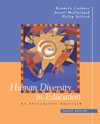 |
1 |  | 
The following statements are true about tolerance or intolerance in the history of America, except: |
|  | A) | The Native American population called the Taino were treated with intolerance by the Spaniards. |
|  | B) | In 1698, South Carolina passed an act exempting Irish and Roman Catholics from new bounties. |
|  | C) | In Florida, Texas, and Kentucky, Black schools were built only after Black citizens paid a second tax to build their own schools. |
|  | D) | In the 1896 Plessy v. Ferguson decision, the Supreme Court held that segregation was prohibited by the Constitution. |
 |
 |
2 |  | 
Which of the following is the1954 Supreme Court decision that stated segregated schools were inherently unequal and that state laws allowing separate schools for blacks and whites were unconstitutional? |
|  | A) | Plessy v. Ferguson |
|  | B) | Lau v. Nichols |
|  | C) | Brown v. The Board of Education |
|  | D) | The Civil Rights Act |
 |
 |
3 |  | 
Title IX of the Education Amendments (1972) assured the following: |
|  | A) | All workers occupying the same position must be paid equally. |
|  | B) | Sex discrimination against students and employees of educational institutions was prohibited. |
|  | C) | Schools were required to assume responsibility for educating all children in the least restricted environment possible. |
|  | D) | Programs were established for children whose first language was not English. |
 |
 |
4 |  | 
Assessment that is sensitive to the role of race, ethnicity, and culture considers the following: |
|  | A) | the sociocultural context of the learner and the learner's family |
|  | B) | the sociocultural context of the examiner |
|  | C) | the selection of appropriate testing instruments or interview procedures |
|  | D) | all of the above |
 |
 |
5 |  | 
Katz's research on the functions of human prejudice shows that the following are all functions served by prejudice except: |
|  | A) | adjustment function |
|  | B) | ego-defense function |
|  | C) | intergroup function |
|  | D) | value-expressive function |
 |
 |
6 |  | 
The authors cite all of the following ways in which children may learn to be prejudiced, except: |
|  | A) | intercultural awareness |
|  | B) | observation |
|  | C) | group membership |
|  | D) | the media |
 |
 |
7 |  | 
The following statements are true for the term White privilege, except: |
|  | A) | White privilege remains largely unconscious for most perpetrators. |
|  | B) | Perpetrators are acutely aware of their oppressive behavior. |
|  | C) | Individuals typically attribute success and status to personal traits rather than situation factors not afforded by all people. |
|  | D) | White privilege exists when White people are not taught to see the corresponding advantage that their color brings them. |
 |
 |
8 |  | 
According to Bennett, the following is not true when it comes to intercultural sensitivity: |
|  | A) | Cross-cultural contact usually has been accompanied by bloodshed, oppression, or genocide. |
|  | B) | Intercultural sensitivity is a natural human characteristic. |
|  | C) | Education and training in intercultural communication is an approach to changing natural behavior. |
|  | D) | Learners are asked to transcend traditional ethnocentrism. |
 |
 |
9 |  | 
Which of the following educational strategies can be employed to reduce prejudice? |
|  | A) | improving social contact and intergroup relations |
|  | B) | increasing cognitive sophistication |
|  | C) | increasing empathy and understanding of the other groups |
|  | D) | all of the above |
 |
 |
10 |  | 
All of the following are examples of educational activities that engage the emotions and may help to produce long-term gains in prejudice reduction, except: |
|  | A) | writing stories |
|  | B) | taking the part of another in a deliberation or a debate |
|  | C) | thinking about one's own thinking |
|  | D) | participating in a "culture shock" simulation |
 |



 2003 McGraw-Hill Higher Education
2003 McGraw-Hill Higher Education